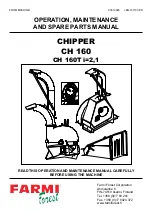
IOM 1242-2 • PATHFINDER
®
MODEL AWV CHILLERS
64 www.DaikinApplied.com
C
IrCuIT
f
unCTIons
The first fan will turn on when condenser saturated
temperature is above the target rather than using the error
accumulator.
Staging Down
When the saturated condenser refrigerant temperature is
below the Target – the active deadband, a Stage Down error is
accumulated.
Stage Down Error Step = (target - Stage Down deadband) -
saturated condenser temperature
The Stage Down Error Step is added to Stage Down
Accumulator once every 5 seconds. When the Stage Down
Error Accumulator is greater than 3°C (5.4°F), a fan stage is
removed.
When a stage down occurs or the saturated condenser
temperature rises back within the Stage Down deadband the
Stage Down Error Accumulator is reset to zero.
Active Deadbands
Stage Up and Stage Down deadbands are determined by set
points as shown in the following table:
Table 53: Stage Deadbands
Fan
stage
Stage Up Setting
Stage Down Setting
0
Fan Stage Up
Deadband 0
---
1
Fan Stage Up
Deadband 1
Fan Stage Down
Deadband 1
2
Fan Stage Up
Deadband 2
Fan Stage Down
Deadband 2
3
Fan Stage Up
Deadband 3
Fan Stage Down
Deadband 3
4
Fan Stage Up
Deadband 4
Fan Stage Down
Deadband 4
5 to 16
Fan Stage Up
Deadband 5
Fan Stage Down
Deadband 5
VFD on 1st Fan of Each Circuit
As an option, the first fan may be driven by a VFD. The VFD
control will vary the fan speed to drive the saturated condenser
temperature to a target value. The target value is normally the
same as the saturated condenser temperature target.
VFD Speed Control
The VFD speed should always be 0% when the fan stage is 0.
When the fan stage is greater than 0, the VFD speed will be
calculated to control the saturated condenser temperature to
the VFD target. The minimum and maximum speed are set by
the VFD Min Speed and VFD Max Speed set points.
Stage Up Compensation
In order to create a smoother transition when the fan stage
increases, the VFD compensates by slowing down initially. This
is accomplished by adding the new fan stage up deadband
to the VFD target. The higher target causes the VFD logic to
decrease fan speed. Then, every 2 seconds, 0.1°C (0.18°F) is
subtracted from the VFD target until it is equal to the saturated
condenser temperature target set point.
Speed Signal to VFD
The fan VFD is controlled using a 0-10 volt signal. When the
fan should be off, the signal will be 0 Vdc. When the fan should
be running, the signal will vary based on the percent speed
calculation.
Signal Signal = Percent Speed / 10
Fan Control - All Fans with VFD
If Fan VFD Configuration is set to All Fan VFD, different control
logic will be used. All fan motors are DC fan motors which
have integrated inverters and are controlled via modbus. This
configuration requires the DC Fan Controller.
System Architecture
Architecture of the control system components involved in
control of the DC fan motors is shown below. Data flows in both
directions on the communication link as well as the Modbus
connection.
Figure 65: Controller Communication Architecture
The following control logic will reside in the DC Fan Controller:
• Automatic control
• Alarm handling per individual fan motor
• Fan motor addressing process
• Fan motor testing control
Normal Control
When Control Mode is set to Auto, the logic in this section
will automatically control the DC fan motors for normal chiller
operation.
The VFD speed should always be 0% when the fan stage is 0.
When the fan stage is greater than 0, the VFD speed will be
calculated to control the saturated condenser temperature to
the VFD target.
Modbus
Unit Controller
DC Fan Controller
Fan Motors
Summary of Contents for Pathfinder AWV Series
Page 4: ......
















































